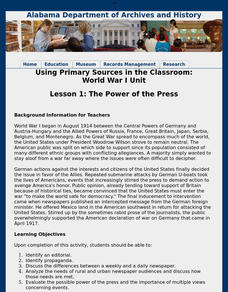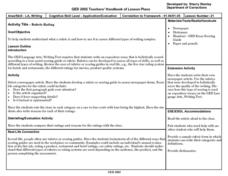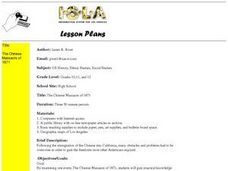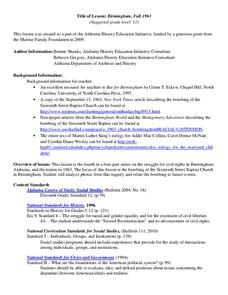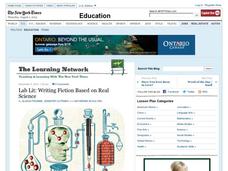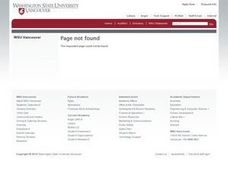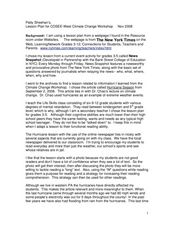NASA
Solar Storms
In this solar storms worksheet, students use an on line source to read newspaper stories about scientific theories and hypothesis related to space weather phenomena. Students answer 7 questions about past solar storms and compare ideas...
Curated OER
News Quiz | April 4, 2012
Everyday there are new headlines to excite your class. After a quick look at the April 4, 2012 edition of the New York Times, your class will take a topical quiz. Find out what they know about current events, and what they retained from...
Curated OER
Cartographer and Journalish as Storytellers
Students collaborate in groups of four students to create a written description of their community during a specific year. They analyze data provided by maps and newspaper articles. They meet as a whole class to discuss their conclusions.
Curated OER
The Power of the Press
Students identify an editorial and propaganda, discuss differences between weekly and daily newspapers, analyze needs of rural and urban newspaper audiences, and evaluate possible power of the press and importance of multiple views...
American Press Institute
Newspapers in Your Life: What’s News Where?
Big news isn't necessarily newsworthy everywhere! How do journalists decide what to cover with so much happening around them? A instructional activity on media literacy examines the factors that affect the media's choice of stories to...
Alabama Department of Archives and History
World War II - Life on the Home Front in Alabama
What was life like for civilians who were home during WWII? The lesson uses a PowerPoint presentation with photos to explain life on the home front was like during World War II, including shortages of food, collecting scrap metal, and...
Curated OER
Women's Right To Vote
Fifth graders explore the history of women's right to vote and identify two of the leaders of the suffrage movement, Alice Paul and Lucy Burns. After completing readings and discussions, they write an article for the newspaper about...
Curated OER
Coal Mine Industrial Picture Analysis
Learners observe coal mine pictures. In this US history lesson, students analyze the pictures realizing that history is shown in pictures and then write a newspaper article about life in a coal town using the pictures as sources of...
Curated OER
When the News is the News
Students share opinions about the factors that influence their newspaper-reading decisions. They study the News Corporation's purchase of Dow Jones & Company by reading and discussing the article "Dow Jones Deal Gives Murdoch a...
Education World
Human Nature- Good or Evil?
Students explore the philosophical nature of good vs. evil. In this literacy/philosophy instructional activity, students read and discuss media articles that illustrate human nature as inherently "good" or "evil." Students practice...
Curated OER
Rubric Rating
Students develop a rubric or scoring guide to assess newpaper articles. They rate the story and write the reasons for the rating. An Essay Scoring Guide is attached for reference.
Curated OER
The Power of the Pen
Learners discuss the personal and historical significance of journals, analyze the issues raised in a N.Y. Times article regarding Anne Frank's diary, and evaluate a Letter to the Editor written in response to the article.
Curated OER
Express Yourself
Students share opinions about the way students behave. They write letters to the editor responding to an article.
Curated OER
Mixed Plate
Young scholars locate a sample restaurant review in a newspaper or magazine. They examine the review to find the opinion of the reviewer and discuss reviews that convey mixed opinions. They compose an original review in a similar style...
Curated OER
Art Smart
Students engage in a lesson that is concerned with the expression of art that is popular in modern times. They read articles from the New York Times and write reflectively about the featured art exhibits. Students use the newspaper to...
Curated OER
Autobiographical Writing
In this unique instructional activity on autobiographical writing, students compare and contrast three types of writing: narrative, poetry and newspaper. Students prepare to produce a short autobiographical writing based on the framework...
Curated OER
The Chinese Massacre of 1871
Students investigate the historical Chinese Massacre of 1871. They conduct Internet research, analyze period maps of Los Angeles, read an article, design a timeline, and write a research paper.
Curated OER
Finding Excellent Nonfiction in Long-form Journalism
How to find engaging, rigorous nonfiction texts through long-form journalism.
Alabama Department of Archives and History
Birmingham, Fall 1963
Can any good come from acts of evil? The 1963 bombing of the Sixteenth Street Baptist Church in Birmingham, Alabama, and the eventual outcomes of the tragedy, are the focus of a lesson that asks groups to examine primary source documents...
The New York Times
Writing Fiction Based on Real Science - NYTimes.com
Refuse to alienate your scientific-minded young scholars during your creative writing unit. Learners explore how literary writing can reflect observable fact, and be based in actual science. The links include examples of fiction and...
Curated OER
The Color of Money
Students explore the success of members of racial and ethnic minorities in the business world through discussing a related New York Times article. They interview successful people in various professions who would be considered minority.
Curated OER
African Americans in the Columbia River Basin
Students research the Columbia River Basin Ethnic History Archive (CRBEHA) and use a variety of primary sources to explore the history of blacks in the region.
Curated OER
Lead Stories about Confederation Lesson 5
Students identify what a lead story is and how to write one, for their simulated newspaper, about Confederation. They use primary-source documents from the "EvidenceWeb" portion of the Learning Centre, on the Library and Archives Canada...
Curated OER
West Climate Change
Students read an internet article about hurricanes. In this hurricane lesson plan, students explain how they form and the damage they bring. They analyze the article and answer questions about it.





